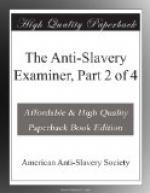To the planters and freed-men in settling the question what wages they should offer and receive, two standards or guides presented themselves,—1. The rate of wages which had been given in Antigua since 1834. 2. The compensation that had been demanded by the Jamaica planters themselves, and adjudged by the magistrates, in case of apprentices buying their own time. Hundreds of planters had declared upon oath what the time of the apprentice was worth to them. Possibly as sellers, in the elasticity of their consciences, they may have set a higher price than they would be willing to give as buyers. In strict honesty, however, it is difficult to see why labor should not be worth to them as much in the one case as the other. The rate of wages fixed upon in Antigua may be seen by a reference to the Journal of Thome and Kimball to be very inadequate to the wants of the laborer. Free labor is there screwed down to the lowest possible point. The wonder is that the laborers should have submitted to such a scale for a moment. But they had no precedent to guide them, no advisers free from the yoke of the proprietary, no valuations given by their own masters, and there was every facility for successful combination on the part of the masters. They must work for such wages as the masters pleased to offer, or starve.
Say Messrs. Thome and Kimball—“By a general understanding among the planters, the rate is at present fixed at a shilling per day, or a little more than fifty cents per week, counting five working days.” This Antigua scale, and not the one they themselves had sold labor by during the apprenticeship, became at once the favorite with a great part of the Jamaica and Barbados planters. If they in any cases offered higher wages, they made it up by charging higher rent for the houses and grounds, which the negroes had built and brought under culture on their properties. It was before the first of August that this procedure was resolved upon by the planters, as we gather from numerous communications in the papers recommending a variety of modes of getting labor for less than its natural market value. We select a single one of these as a specimen, by the application to which of a little arithmetic, it will be perceived that the employer would bring the laborer in debt to him at the end of the year, though not a moment should be lost by sickness or other casualty. The humanity of the document is perfectly of a piece with that of the system which would civilize mankind by making merchandize of them.
To the Editor of the Morning journal.
SIR,—Let meetings be held, not only in every parish, but in every district of a parish, and let all land-owners, &c., agree not to rent land under L8[A] per acre, and not to sell it for less than double that sum. Should a few be found regardless of the general weal, let the proprietary, &c. join and purchase such lands, and if otherwise, it is presumed the dissentients to the measure would




